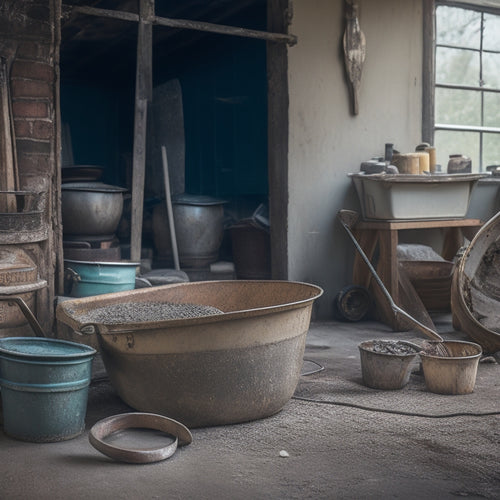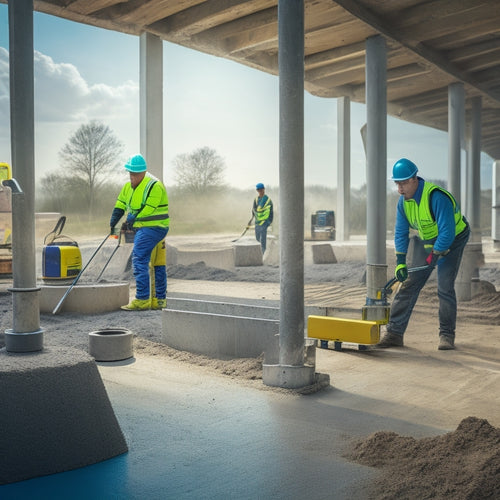
3 Best Concrete Crack Repair Tools for Homeowners
Share
You'll need a concrete chisel to remove loose debris and widen cracks, a concrete scraper/wire brush to clean the area for strong bonding, and epoxy/polyurethane compounds for excellent bonding and resistance to water and chemicals. These three tools form the foundation of a successful crack repair. As you prepare to tackle your concrete crack repair project, it's vital to have the right tools in your toolbox to guarantee a durable and long-lasting fix - and understanding the role each tool plays is important to achieving the best results.
Key Takeaways
• A concrete chisel is essential for removing loose debris and widening cracks for effective repair.
• A concrete scraper or wire brush helps clean the crack area to ensure strong bonding of the repair material.
• Epoxy or polyurethane compounds are preferred for their excellent bonding and resistance to water and chemicals.
• A crack chaser, such as a handheld saw or grinder, is necessary for widening and cleaning cracks before repair.
• Safety goggles are crucial for protecting eyes from debris and chemicals during the repair process.
Top Picks for Crack Repair
You'll need a reliable arsenal of concrete crack repair tools to tackle cracks of various sizes and types, and the following top picks will help you get started. When it comes to crack repair techniques, having the right tools can make all the difference.
For instance, a high-quality concrete chisel is vital for removing loose debris and widening the crack to prepare it for filling. A concrete scraper or wire brush can also be used to clean the area and guarantee a strong bond between the old and new concrete.
Material selection is also important in crack repair. Epoxy-based or polyurethane-based concrete repair compounds are popular choices due to their excellent bonding properties and resistance to water and chemicals. You may also consider using a concrete patching compound for smaller cracks or a self-leveling compound for larger ones.
Additionally, a mixing stick and a trowel are necessary for applying and smoothing out the repair material. By investing in these top picks, you'll be well-equipped to tackle a wide range of concrete crack repair projects and achieve professional-looking results.
Essential Tools for Sealing Cracks
Essential Tools for Sealing Cracks
When sealing cracks, having the right tools at your disposal is essential, as they enable you to efficiently inject repair materials into narrow openings and guarantee a watertight seal. To achieve professional-grade results, you'll need to invest in tools that facilitate effective crack sealing techniques and surface preparation.
Here are the essential tools you'll need:
| Tool | Purpose | Description |
|---|---|---|
| Crack chaser | Surface preparation | A handheld saw or grinder used to widen and clean cracks |
| Injection gun | Material injection | A tool that forces repair materials into cracks with high pressure |
| Mixing stick | Material preparation | A tool used to mix and blend repair materials |
| Caulk tube | Material application | A tube used to apply sealants and adhesives to cracks |
| Safety goggles | Personal protection | Protective eyewear to prevent injury from debris and chemicals |
DIY-Friendly Repair Solution Kits
The market offers a range of DIY-friendly repair solution kits that provide homeowners with a convenient and cost-effective way to address common crack issues.
These kits usually include a specialized epoxy or polyurethane-based resin, injection ports, and other necessary accessories. You can choose from a variety of kits designed for specific types of cracks, such as hairline cracks, wide cracks, or corner cracks.
When selecting a repair kit, it's important to read user reviews and product descriptions carefully.
Look for kits with high-strength resins that can bond well with the surrounding concrete. You should also consider the ease of application, as some kits may require specialized tools or skills.
Additionally, check the kit's coverage area and material quantity to verify it's suitable for your repair needs.
Frequently Asked Questions
Can I Use Concrete Crack Repair Tools on Freshly Poured Concrete?
When dealing with fresh concrete, you shouldn't use concrete crack repair tools immediately.
Fresh concrete needs time to cure and settle, and applying repair methods too soon can compromise its integrity.
Instead, allow the concrete to cure fully, usually within 24-48 hours, before evaluating and addressing any cracks that may appear.
This guarantees the repair is effective and long-lasting.
How Long Does It Take for Concrete Repair Compounds to Fully Dry?
When you apply concrete repair compounds, you'll need to wait for the drying time to guarantee a strong bond.
The curing process typically takes anywhere from 15 minutes to several hours, depending on the product and environmental conditions.
You'll know it's fully dry when the compound reaches its recommended strength, usually indicated on the product label.
Follow the instructions carefully to avoid compromising the repair.
Are Concrete Crack Repair Tools Suitable for Large Commercial Projects?
When tackling large commercial projects, you'll need concrete crack repair tools that can handle industrial applications.
You're looking for tools that prioritize durability, able to withstand the demands of large-scale repairs.
Assess the tool's build quality, material, and construction to guarantee it can handle the workload.
A durable tool will save you time and money in the long run, allowing you to complete projects efficiently and effectively.
Can I Paint Over Repaired Cracks With Regular Latex Paint?
As you triumphantly hold aloft your freshly repaired concrete, reminiscent of a medieval knight brandishing a victorious sword, you wonder: can I paint over those pesky cracks with regular latex paint?
The answer lies in crack visibility and paint adhesion. If the repair is smooth and even, you're good to go.
However, if the crack is still slightly visible or the surface is rough, the paint may not adhere properly, compromising its durability.
Do I Need to Seal Cracks in My Concrete Garage Floor?
You're wondering if sealing cracks in your concrete garage floor is necessary. The answer is yes.
Crack sealing offers numerous benefits, including preventing water infiltration, reducing further damage, and enhancing overall garage floor maintenance.
By sealing cracks, you'll protect your floor from stains, pitting, and deterioration, ensuring a safer and more durable surface.
It's an essential step in maintaining your garage floor's integrity, so don't skip it!
Conclusion
As you finish reading this article, it's likely you're already facing a concrete crack repair project. Coincidence? Probably not. Cracks are inevitable, but with the right tools, you can seal them like a pro.
The three tools mentioned above will help you do just that. By investing in a quality crack repair kit, a reliable crack chaser, and a durable sealant, you'll be well-equipped to tackle any crack that comes your way.
Related Posts
-

Must-Have Tools for Laying Concrete Tiles
When laying concrete tiles, you'll need a range of essential tools to get the job done right. Start with subfloor pre...
-

Top Tools for Mixing Concrete at Home
When mixing concrete at home, you'll need a range of tools to guarantee a successful operation. Start with essential ...
-

What Tools Ensure Precise Concrete Leveling Results
You need a range of specialized tools to achieve precise concrete leveling results. Laser leveling instruments provid...


